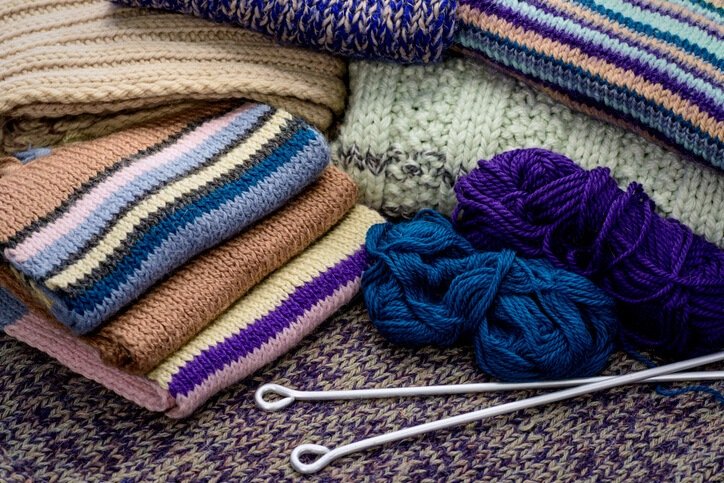Cashmere goats are multi purpose:
They produce 3-4 ounces of fine, soft fiber every year which can be processed into wool for knitted garments
Their pelts can be used for rugs and seat covers
Their meat is low in cholesterol
Their history:

Cashmere goats originally came from the Himalayas and migrated with Chinese herders to Mongolia, Tibet and Northern provinces of China in the 10th and 12th centuries. With the development of the Asian empire, cashmere slowly began to enter the trade routes in the West. In the 13th century Marco Polo brought cashmere to Italy where it became the fiber of choice among the aristocratic elite.
The Changthangi or Pashmina goat is a breed of goat from Tibet or neighbouring areas in the Ladakhi Changthang, usually raised for meat or cashmere wool (known as pashmina once woven).
These goats grow a thick, warm fleece. They survive on grass in Ladakh, where temperatures plunge to as low as -20 °C (-4.00 °F). These goats provide the wool for Kashmir’s famous Pashmina shawls. Shawls made from Pashmina wool are considered very fine, and are exported worldwide.
Noori, the world’s first cloned Pashmina goat, was cloned at the Faculty of Veterinary Sciences and Animal Husbandary of the Sher-e-Kashmir University of Agricultural Sciences and Technology of Kashmir (SKUAST) in Shuhama, 25km east of Srinagar, on March 15, 2012.
pashmina refers to a type of fine cashmere wool and clothes made from this wool. the name pashmina is derived from Pashmineh (persian pashm (wool). The wool comes from changthangi or pashmina goat, which is a special breed of indigenous goat to high altitude of the Himalayas. All the pashmina artisans in the region of kashmir hand made this shalls and embroidery is also done by hand.
Kashmir pashmina has been famous for centuries due to its quality and products like plain pashmina, woven jamawars, embroided pashmina, ladies and gents 6 & 7 yards. It is history that Mogul emperor king Akbar presented a gift of Kashmir jamawar to the Queen of England

Production:
Every year during winter the goats shed their coat, one goat may yield upto 3-5 ounces of the fibre. To keep up with the increasing demand, goats are now commercially reared all across kashmir, ladakh and Nepal.
Our cashmere goats have a fine, downy undercoat which protects them from the cold winters, Each spring the fleeces are removed by either combing or shearing. A typical adult goat produces 3-4 oz. of pure down, enough for about 1/3 of a sweater. The finest cashmere is harvested when the goat is 2-4 years old and after the age of five, the goat’s value is based on its ability to produce offspring. Once the cashmere is combed off or sheared, the dirt, grass and other non-fiber contaminants must be removed. The fiber is then sorted by fineness and length. Coarse hairs are removed leaving behind the medium and long fine hairs. The shortest cashmere hairs are extremely soft, but because they are so short they will pill if they are woven into clothing. The fleece is then sorted by color which can be white, off white, tan, brown or grey. The fleece is then washed, dried and spun into skeins of yarn or left as raw roving. It takes approximately a year’s worth of wool from three to four goats in order to make a woman’s single ply cashmere sweater. Cashmere is eight times warmer than sheep’s wool and 33% lighter. Cashmere fiber has a crimp or curl that sheep’s wool does not have. This extra crimp holds pockets of warm air close to the body. It is the softest animal fiber readily available on the market measureable by its low micron count. The micron count is the measure of the diameter of the fiber and the lower the number, the softer the fiber. The finest cashmere has a micron count of 16 or less.
Un-dyed cashmere ranges in color from a snowy white to a chocolate brown with variations of brownish-grey. White is the most valuable because it can readily accept dye. However, the more dye that is used, the coarser it feels. The naturally darker cashmere fibers will be dyed when trying to achieve a black, dark navy, charcoal or brown. The natural white cashmere fibers will be bleached white and dyed into pastel colors.
Most cashmere sweaters have a label that says Dry Clean Only, but this is to remove liability should you incorrectly wash your cashmere and ruin it. The quality of a cashmere item can actually improve if you wash it properly in cold water by hand or machine and dry without any heat. It is more expensive to hand knit a cashmere sweater than to buy one because the hand knitting yarn is much thicker than commercial yarn. The cashmere sweater you buy in a store uses a much thinner commercial yarn which cannot be hand knit. The world produces 9,000-10,000 tons of cashmere each year.



